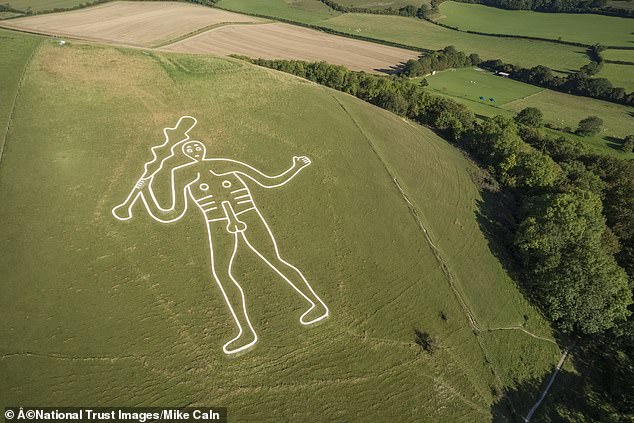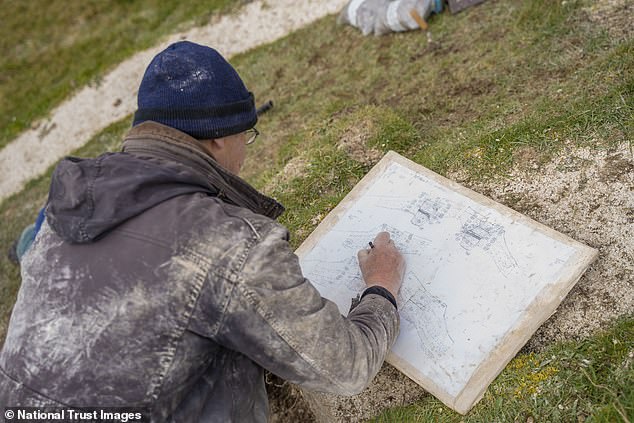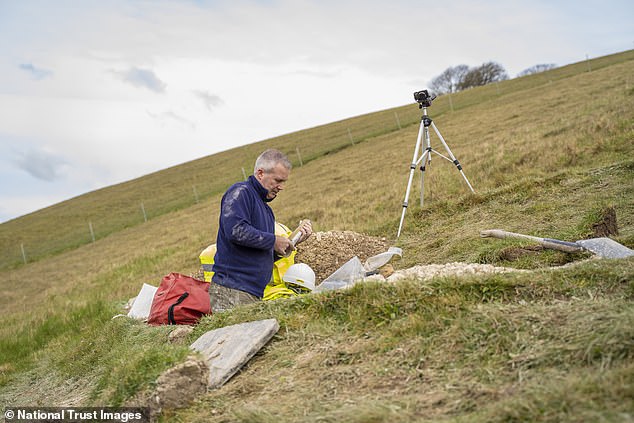Is the mystery of the Cerne Giant finally solved? UK's largest chalk man was made in Saxon times 'in tribute to the God Helith' and NOT to insult Oliver Cromwell (but his appendage may have been added later for laughs), scientists say
- The National Trust has been working to correctly age Dorset's Cerne Giant
- Archaeologists carried out sediment analysis of the chalk 3ft below the surface
- This allowed them to date the era it was made to between 700 AD and 1100 AD
- Historians predict the giant may depict an early Anglo Saxon god known as 'Heil'
12 May 2021
Britain's largest chalk hill figure, the Cerne Giant, was created in the late Saxon period, but may have had his notable appendage added in the 17th century.
Original theories suggested the giant may have been created by local landowners as an insult to Oliver Cromwell, but new dating mostly rules this out, suggesting it was created between the 7th and 11th century, with the appendage added later.
Archaeologists working for the National Trust carried out state-of-the-art sediment analysis of the 180ft naked figure brandishing a giant club to determine its age.
The origins and purpose of the artwork, overlooking the village of Cerne Abbas in Dorset, have been shrouded in mystery for generations.
Theories have ranged from an ancient spirituality symbol or likeness of Greco-Roman hero Hercules to a caricature of Oliver Cromwell, with the club a reference to repressive rule and the phallus a mockery of his puritanism.
Following the latest analysis of the soil and markings, archaeologists have concluded the giant was probably first constructed in the late Saxon period, between 700 and 1100 AD, and may depict an early Anglo Saxon god known as 'Heil'.
However, making use of Lidar technology to look for no longer visible lines, they found he may originally have been wearing trousers, with evidence the phallus was added later, in the 17th century to turn it into a 'figure of fun'.
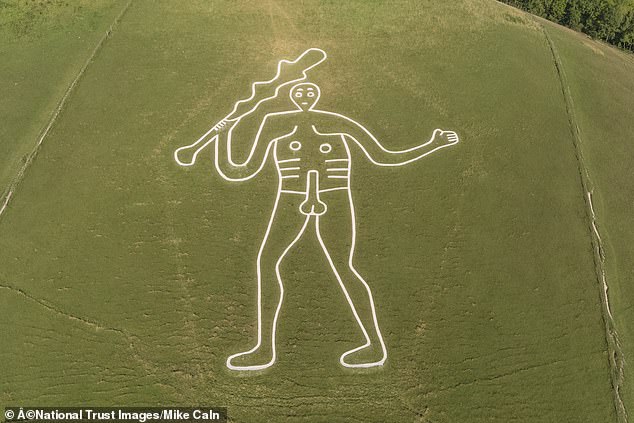
Britain's largest chalk hill figure, the Cerne Giant, was created in the late Saxon period, not as an insult to Oliver Cromwell as previously thought, a new study reveals

Archaeologists working for the National Trust carried out state-of-the-art sediment analysis of the 180ft naked figure brandishing a giant club to determine its age
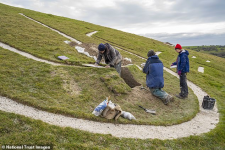
The origins and purpose of the artwork, overlooking the village of Cerne Abbas in Dorset, have been shrouded in mystery for generations
National Trust flyover of Cerne Giant for archaeological study
Phillip Toms, professor in physical geography at the University of Gloucestershire, studied the samples using optically stimulated luminescence (OSL).
This technique can show when individual grains of sand in the sediment were last exposed to sunlight and help date them.
Material taken from the deepest layer 3ft below the surface yielded a date range of 700-1100AD, which suggests the giant was first made by late Saxons.
National Trust senior archaeologist Martin Papworth said the archaeology on the hillside was surprisingly deep, with people re-chalking for a long period of time.
'The deepest sample from his elbows and feet tells us he could not have been made before 700AD, ruling out theories that he is of prehistoric or Roman origin.
'This probable Saxon date places him in a dramatic part of Cerne history,' he added.
Cerne Abbey was founded in 987AD and some think it was set up to convert the locals from the worship of an early Anglo Saxon god known as 'Heil' to Christianity.
'The early part of our date range does invite the question, was the giant originally a depiction of that god?,' asked Papworth.
Other samples - taken with permission from Historic England and the Secretary of State - gave later dates of up to 1560 AD.
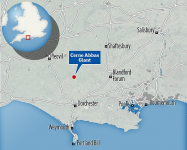
This presented Papworth with a conundrum, as the earliest documented record of the giant is a church warden's account of repairing him in 1694.
His working theory is that the giant may have been a medieval creation but then - for reasons we may never know - was neglected for several hundred years, before being rediscovered by following generations of local residents.
Papworth told The Times that a Lidar survey revealed that he once had a belt that ran across his body but had been 'interrupted by his penis'.
'So you could argue that he had trousers on originally and later on, perhaps as late as the 17th century, the penis was incorporated,' he said.
'So it may not be such a shocking thing to have had him on the hillside in the medieval period because he may have had trousers on. That is likely.'
Gordon Bishop, chairman of the Cerne Historical Society, described the results as both intriguing and surprising.
'What I am personally pleased about is that the results appear to have put an end to the theory that he was created in the 17th century as an insult to Oliver Cromwell. I thought that rather demeaned the giant,' he said.

Following the latest analysis of the soil and markings, archaeologists have concluded the giant was probably first constructed in the late Saxon period, between 700 and 1100 AD, and may depict an early Anglo Saxon god known as 'Heil'
